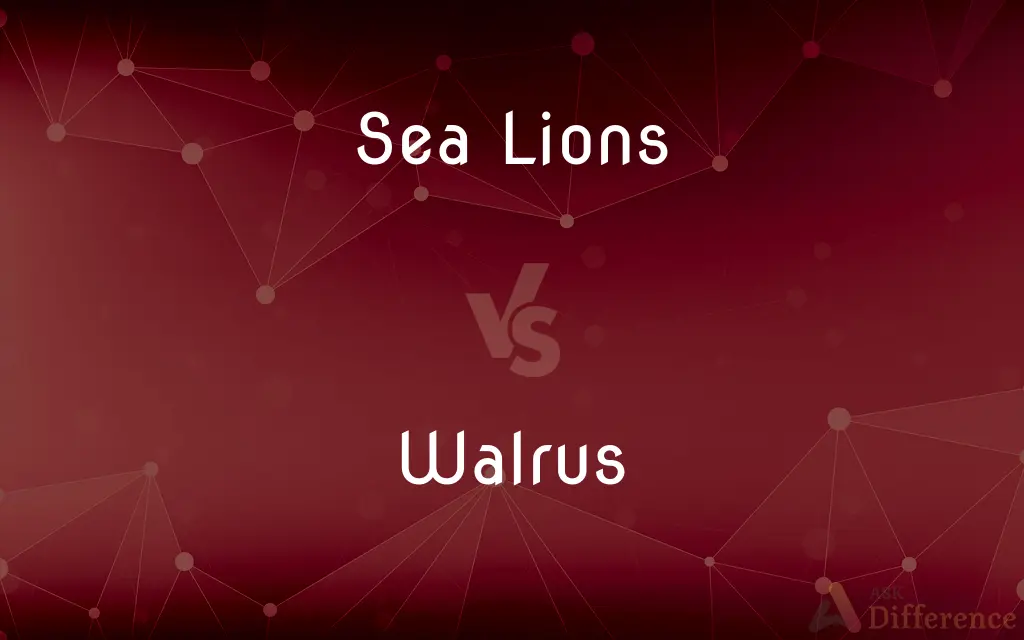Sea Lions vs. Walrus — What's the Difference?
Edited by Tayyaba Rehman — By Fiza Rafique — Published on December 11, 2023
Sea lions are slender, have external ear flaps, and use flippers for swimming. Walrus are bulkier, have tusks, and lack external ear flaps.

Difference Between Sea Lions and Walrus
Table of Contents
ADVERTISEMENT
Key Differences
Sea lions are marine mammals known for their slender bodies and adaptability to various aquatic habitats. They possess external ear flaps that distinctly differentiate them from other pinnipeds. On the other side, walrus are easily identifiable by their massive size and prominent tusks which are elongated upper canine teeth.
Sea lions have long, wing-like front flippers that they use efficiently for swimming. These flippers also assist them in "walking" on land, as they can rotate underneath their bodies. Contrarily, walrus, while also having flippers, have shorter, less wing-like front flippers and move more clumsily on land, often dragging their bulky bodies.
One of the primary habitats of sea lions is rocky shores, where they can often be seen basking in the sun. They are quite social animals and are commonly spotted in large groups. In contrast, walrus prefer Arctic regions, lounging on ice floes. They tend to form social clusters, especially when they haul out onto land or ice.
When it comes to diet, sea lions primarily feed on fish and squid, using their speed and agility to chase their prey. Walrus, however, mainly dine on benthic invertebrates, using their sensitive whiskers to detect prey on the seafloor.
Comparison Chart
Body Shape
Slender
Bulky
ADVERTISEMENT
Distinct Features
External ear flaps
Prominent tusks
Front Flippers
Long and wing-like
Shorter, less wing-like
Habitat
Rocky shores, various aquatic habitats
Arctic regions, ice floes
Diet
Fish and squid
Benthic invertebrates
Compare with Definitions
Sea Lions
Marine mammals with slender bodies and external ear flaps.
We watched the sea lions sunbathing on the rocky shore.
Walrus
Animals known for their hefty bodies and short front flippers.
The walrus moved rather clumsily on land, dragging its bulk.
Sea Lions
Predators that primarily consume fish and squid.
Sea lions are skilled hunters, darting through the water to catch their prey.
Walrus
Large marine mammals distinguished by their tusks and whiskers.
The walrus used its tusks to haul itself onto the ice floe.
Sea Lions
Social animals often found in large groups on land or in water.
A noisy group of sea lions claimed the dock as their resting place.
Walrus
Pinnipeds that lack external ear flaps and inhabit Arctic regions.
The Arctic expedition provided a unique opportunity to observe walrus in their natural habitat.
Sea Lions
Mammals adept at "walking" on land using their flippers.
It's amusing to watch sea lions waddle on the beach using their flippers.
Walrus
Social creatures that often rest on ice floes in groups.
As we approached, we saw a group of walrus lounging together on an ice patch.
Sea Lions
Pinnipeds known for agile swimming using long front flippers.
The sea lions danced gracefully through the water, chasing fish.
Walrus
A large marine mammal (Odobenus rosmarus) of Arctic regions, related to the seals and having two long tusks, tough wrinkled skin, and four flippers.
Walrus
A large Arctic marine mammal related to seals and having long tusks, tough, wrinkled skin, and four flippers, Odobenus rosmarus.
Walrus
A man with a walrus moustache.
Walrus
To hunt walruses
Walrus
To be like a walrus
Walrus
To move dragging one's belly along the floor
Walrus
To hang like a walrus's moustache
Walrus
To be prominent, like tusks
Walrus
A very large marine mammal (Trichecus rosmarus) of the Seal family, native of the Arctic Ocean. The male has long and powerful tusks descending from the upper jaw. It uses these in procuring food and in fighting. It is hunted for its oil, ivory, and skin. It feeds largely on mollusks. Called also morse.
Walrus
Either of two large northern marine mammals having ivory tusks and tough hide over thick blubber
Walrus
Feeders of benthic invertebrates, using whiskers for detection.
With its sensitive whiskers, the walrus felt for clams on the ocean floor.
Common Curiosities
Are sea lions social animals?
Yes, sea lions are social and are often seen in large groups.
Do sea lions have tusks like walrus?
No, sea lions do not have tusks, which are a prominent feature of walrus.
What do sea lions primarily eat?
Sea lions mainly feed on fish and squid.
Where do walrus typically live?
Walrus are native to Arctic regions and often rest on ice floes.
What's the primary diet of a walrus?
Walrus mainly eat benthic invertebrates, detected using their whiskers.
How do walrus move on land?
Walrus move more clumsily on land, often dragging their hefty bodies.
Where can sea lions be commonly found?
Sea lions can be found on rocky shores and various aquatic habitats.
What makes walrus easily identifiable?
Walrus are known for their bulky bodies and prominent tusks.
Do walrus have external ear flaps like sea lions?
No, walrus lack external ear flaps.
Which animal is larger, sea lions or walrus?
Walrus are generally larger and bulkier than sea lions.
What are the distinguishing features of sea lions?
Sea lions have slender bodies and external ear flaps.
Are walrus considered social mammals?
Yes, walrus are social and often form clusters on land or ice.
How do sea lions use their flippers on land?
Sea lions can "walk" on land by rotating their flippers underneath their bodies.
How do walrus use their tusks?
Walrus use their tusks for various purposes, including hauling themselves onto ice and for social displays.
Can both sea lions and walrus be found in the same habitats?
While there may be some overlap, sea lions prefer rocky shores, while walrus are more commonly found in Arctic regions on ice floes.
Share Your Discovery

Previous Comparison
Primary Key in DBMS vs. Unique Key in DBMS
Next Comparison
Altered vs. ChangedAuthor Spotlight
Written by
Fiza RafiqueFiza Rafique is a skilled content writer at AskDifference.com, where she meticulously refines and enhances written pieces. Drawing from her vast editorial expertise, Fiza ensures clarity, accuracy, and precision in every article. Passionate about language, she continually seeks to elevate the quality of content for readers worldwide.
Edited by
Tayyaba RehmanTayyaba Rehman is a distinguished writer, currently serving as a primary contributor to askdifference.com. As a researcher in semantics and etymology, Tayyaba's passion for the complexity of languages and their distinctions has found a perfect home on the platform. Tayyaba delves into the intricacies of language, distinguishing between commonly confused words and phrases, thereby providing clarity for readers worldwide.
















































